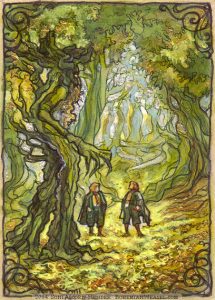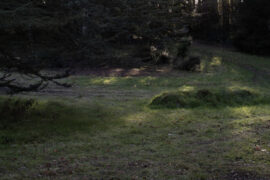Ents are worth listening to.
Springing from the imagination of J.R.R. Tolkien, these tree-herding creatures are slow but powerful, ancient but attentive, and earnest but jovial. Their communicative habits, however, require laborious patience from the listener. In The Two Towers, the Ent known as Treebeard explains to his Hobbit guests that Old Entish ‘is a lovely language, but it takes a very long time to say anything in it, because we do not say anything in it, unless it is worth taking a long time to say, and to listen to.’[1]
Like all languages, Old Entish is intricately connected to how its speakers think. The thorough deliberation of their speech contributes to the thorough deliberation of their thought processes, and vice versa. As a result, they are careful to accurately identify the things they think and talk about; they try to get down to the truth of what things are before they take action. Making decisions, observes Treebeard, does not take them so long as ‘going over all the facts and events that they have to make up their minds about.’[2] They believe that accurately identifying a thing — or person, or place, or idea — is a first and vital step in properly engaging with it. Precise identification will reap clarity of thought and pave the way for appropriate interaction. Sloppy or hasty (Ents are particularly wary of haste) attempts at identification often reap confusion, miscommunication, and poor interaction.
The Entish attitude toward language reflects aspects of Tolkien’s own attitude. In addition to being an author, Tolkien was a philologist with a particular interest in the development of languages and the relationships between words, their sounds, and their meanings. In fact, the world of Middle-earth began as a context in which the languages he had already invented could have a place and a history. He was not alone in his enthusiasm.
Several of his friends, including C.S. Lewis and Owen Barfield, shared his interest in the workings and influence of language. Lewis devoted an essay to considering the metaphors we use, and particularly how the clarity of our thinking is inhibited when we lean on phrases that no longer carry meaning.[3] Barfield devoted whole sections of books to the relationship between words, meaning, and thought. He was particularly concerned that human consciousness had developed from a state of ‘original participation’ (an awareness of nature and reality) to a state of confusion in which our language has become so disconnected from real meaning that our theoretical thoughts are in danger of bearing no weight. He hoped that through imagination we might wed words to real meaning once again. In The Lord of the Rings, Tolkien attempts to do just that:
he invites readers to consider the nature of language by joining Hobbits as they converse with Treebeard and experience the culture of the Ents. In particular, the Entish use of names creatively illustrates the relationship that should exist between words and meanings.

Although Treebeard is the name by which the chief Ent introduces himself to the Hobbits, Merry and Pippin, it is only a nickname given for convenience. He refused to tell them his true name. ‘Not yet at any rate,’ he explained, ‘For one thing it would take a long while: my name is growing all the time, and I’ve lived a very long, long time; so my name is like a story. Real names tell you the story of the things they belong to in my language.‘[4] Rather than a simple label by which persons mutually agree to identify an individual, the name of an Ent attempts to fully apprehend their nature by working their story into their name. This tradition implies that the one named is made up not only of the essence that makes them a person, but also of their interactions with the world. That is why Entish names are growing all the time: the named thing is itself constantly growing. Every remarkable action, be it honorable or dishonorable, contributes a chapter to their story and a title to their name. Names become a restatement of their history; a succinct but thorough description of them as made evident by their story.
Although explicitly articulated by Treebeard, this attitude toward names is evident again and again throughout The Lord of the Rings. The primary names of the characters are often accompanied by titles that indicate their rank, or bring to mind exceptional acts that they have accomplished. Aragorn, for instance, has many titles that correspond to various roles or feats for which he is known. As Elessar, heir of Isildur, he is the first King of the Reunited Kingdom; and after the extraordinary journey of the Three Hunters, Eomer names Aragorn ‘Wingfoot.’[5] Likewise, the humble Hobbit Frodo, through his adventures, is given the noble titles of Elf-friend and Ring-bearer. Tolkien’s technique may have also been influenced by his Christianity. Consider some of the names of Christ that remind us of how He interacts with the world: the Vine, the Door, the Light, the Lamb, and more.[6]
Inversely, the only character in The Lord of the Rings not given a name is the ambassador of Sauron that stood at the Black Gate, known only as the Mouth of Sauron. The absence of his real name serves to prove a point: his name is not given because ‘he himself had forgotten it.’[7] His identity had been lost in his service to the dark lord; his lack of name reflects his lack of himself. His condition resonates with the observation of Job’s friend Bildad in Job chapter eighteen: the memory of the wicked perishes from the earth, and ‘he has no name in the street.’[8]
Why, though, was Treebeard hesitant to share his true name, as if it were considered private? When the Hobbits initially asked for his name, he protested, ‘Hoo! Now that would be telling! Not so hasty!’[9] He even cautioned the Hobbits against sharing their names with him: ‘I am honoured by your confidence,’ he expressed, ‘but you should not be too free all at once.’[10] Treebeard’s attitude suggests that to know someone’s true name — and thus, to know his or her story — has real power that should not be offered lightly.
To the Ent, knowledge of a person’s name means knowledge of their strengths and weaknesses, and the power to build them up or tear them down. Treebeard’s warning is to exercise caution in making oneself so vulnerable. Perhaps this is why Sauron did not want to be named, because he did not want his nature to be widely known.[11]
If, as Treebeard explained, ‘names are the stories of the things they belong to,’ and your story tells who you are, then what does this story consist of? Perhaps Tolkien’s Christianity would influence him to answer that your story begins with your identity as a person, as a human being made in the divine image. Your story is then placed in the context of history. Perhaps this is why the first titles given to most characters in Middle-earth are statements of their heritage: such as Aragorn, son of Arathorn, or Frodo son of Drogo. From these foundations, your story is built from the interactions between you and the world.
Thankfully, the whole of The Lord of the Rings is filled with the stories of people from humble beginnings and imperfect pasts, whose decisions and actions turn their true names into exciting tales of faithful living and heroic acts.
[1] J.R.R. Tolkien, The Two Towers (New York: Houghton Mifflin Co., 1994), 454.
[2] Ibid., 471.
[3] C.S. Lewis, “Bluspels and Flalansferes: A Semantic Nightmare,” in Selected Literary Essays, edited by Walter Hooper (New York: Cambridge University Press, 2013).
[4] Ibid., 454.
[5] Ibid., 426.
[6] John 15:5; John 10:9; John 8:12; John 1:29, English Standard Version.
[7] J.R.R. Tolkien, The Return of the King (New York: Houghton Mifflin Co., 1994), 870.
[8] Job 18:17, English Standard Version.
[9] Tolkien, The Two Towers, 453.
[10] Ibid., 454.
[11] Ibid., 406.





